Food in Samothraki is simple and tasty, made from fresh local ingredients, probably very reminiscent of how Greek grandmas used to cook once upon a time.
There aren't any fancy restaurants on the island, just small taverns and cafés. The owners are often also managers, cooks, and waiters, and usually, everyone in the family has his or her role to play in the business.
Oftentimes, the menu is hand-written in a notebook or scribbled with chalk on a blackboard. At the beginning or the end of the season, the menu is just table decoration - you are told what's available by the waiter. Prices are considerably lower compared to other Greek islands.
When you sit down at a tavern, the first thing they do is lay a disposable tablecloth. Then, the complementary water in a carafe or reusable bottle will follow. It's from the tap, but don't be afraid to drink it, as Samothraki has some of the best and cleanest water in Greece. Less often, you will be brought bottled water, in which case it will appear on the bill at the end (1.5-2 EUR/bottle).
In many places, the portions are large and suitable for several people. Greeks have the habit of ordering several courses and sharing them. I advise you to do the same, as you'll get to taste as many dishes as possible, but also avoid wasting money and food.
Once your meal is finished, you won't be pressured to leave or order anything else. The downside is that they won't clear the dirty plates either. If you want to leave, it's best to go inside and pay directly. Often (especially outside of peak season), after you've requested the check, you'll be offered a small dessert on the house.
Appetizers
The appetizers are the ones you typically find everywhere in Greece, but thanks to the natural, local ingredients they are extra tasty.
If you like cheese, I recommend tyrosalata (cheese spread), and the tyrokafteri (ie spicy cheese) version. At some taverns (for example at O Psaras near Therma or at I Synandisi in Kamariotissa) you may find it under the name chtypiti, which would translate as "beaten". It is a cream cheese (more or less spicy) mixed with fat yogurt, finely chopped hot peppers, olive oil and spices. It costs between 4 and 6 EUR/portion and goes great with fresh bread. Look for it in the appetizer or salad sections of the menus.
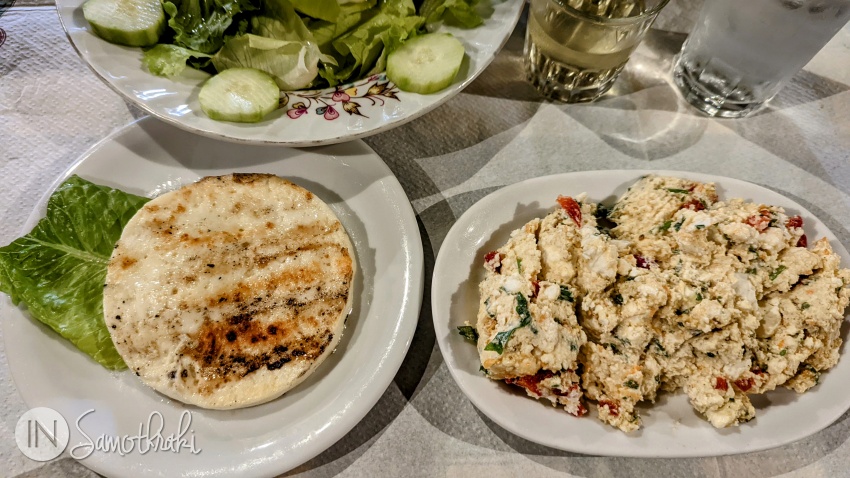
By the way, the bread prepared on the island is delicious and almost impossible to refuse. The oldest bakery in Samothraki has been operating in Chora for over 150 years.
Other traditional cheese dishes are bougiourdi (baked cheese with tomatoes, bell peppers and/or hot peppers, olive oil and oregano) and saganaki cheese (breaded). The cheese (feta or hard) can also be thrown on the grill, while feta also appears on menus in its plain version, with olive oil and oregano on top.
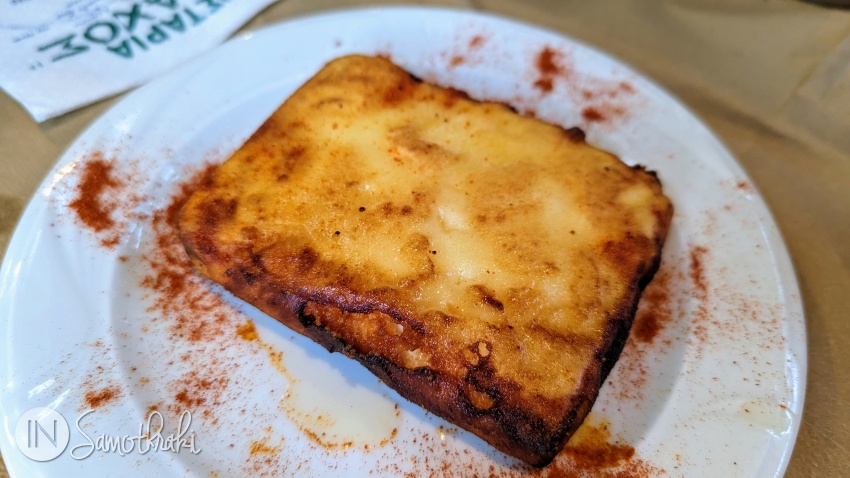
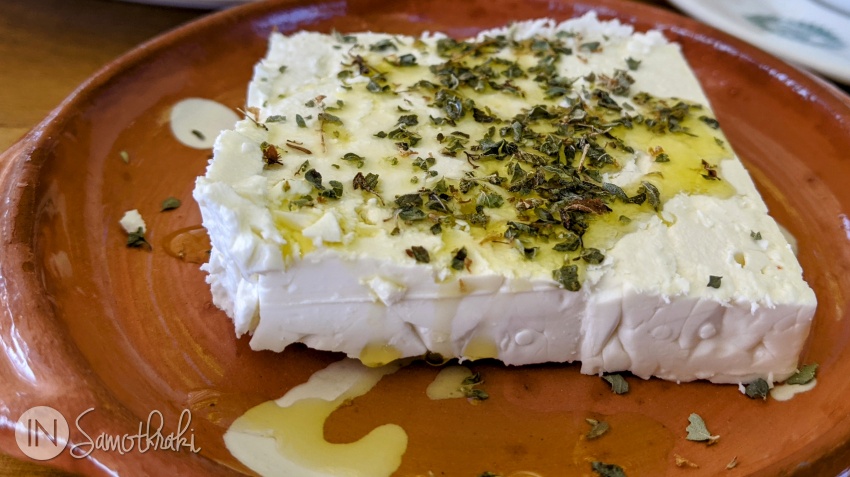
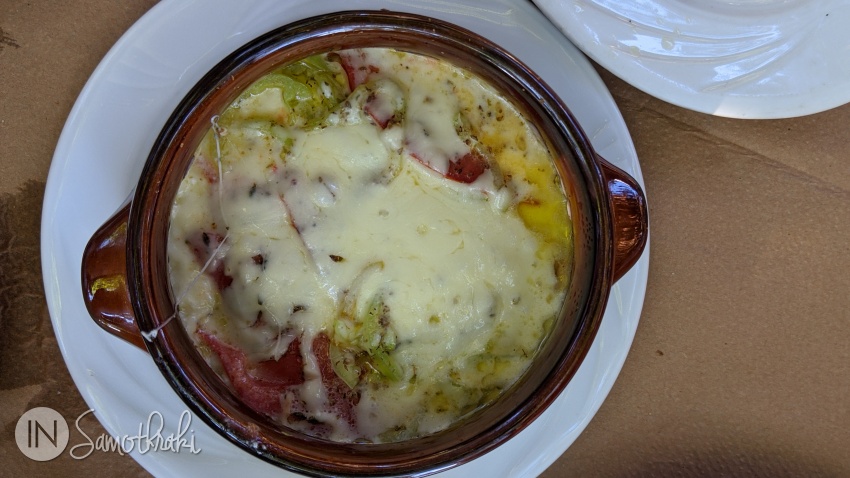
The graviera aged cheese from the Papanikolau farm in Makrylies is exceptional and might make an appearance on the menu of the To Stenaki tavern in Chora.
A special mention goes to myzithra, a curd-like cheese with a delicate taste that is often accompanied by honey.
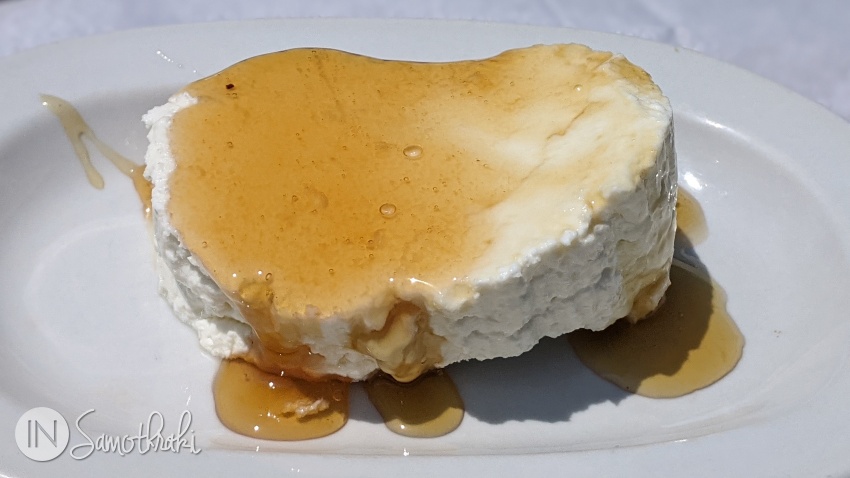
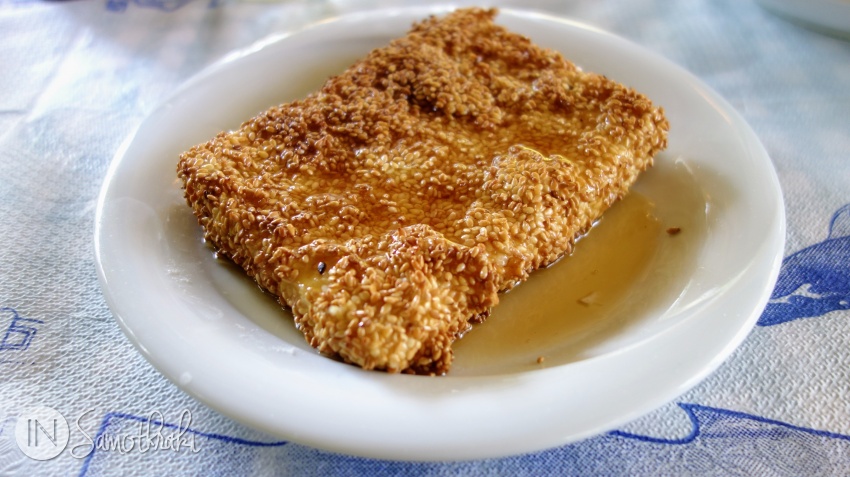
You will also find roe salad (taramas or taramosalata) or eggplant salad (melitzanosalata), fried zucchini, stuffed pumpkin flowers, zucchini or tomato meatballs, sarmas in vine leaves with rice (dolmadakia), fava (a cream of dried yellow peas), skordalia (potato and garlic spread), grilled peppers (spicy or not) or the well-known tzatziki.
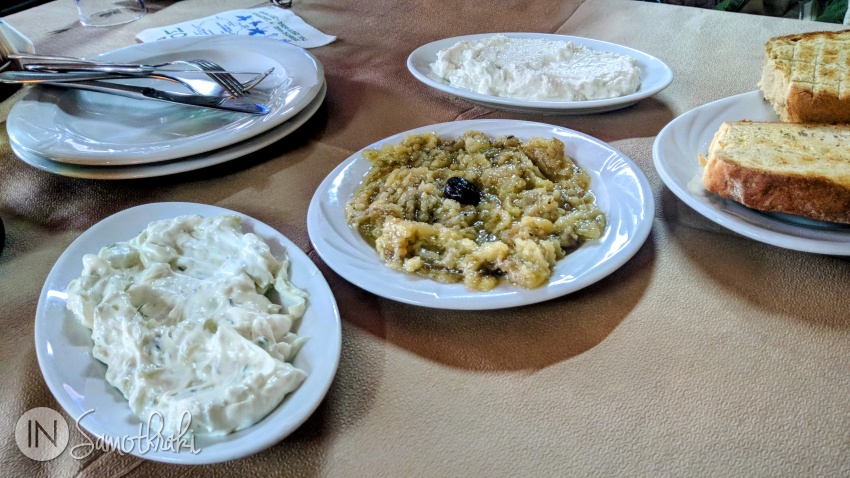
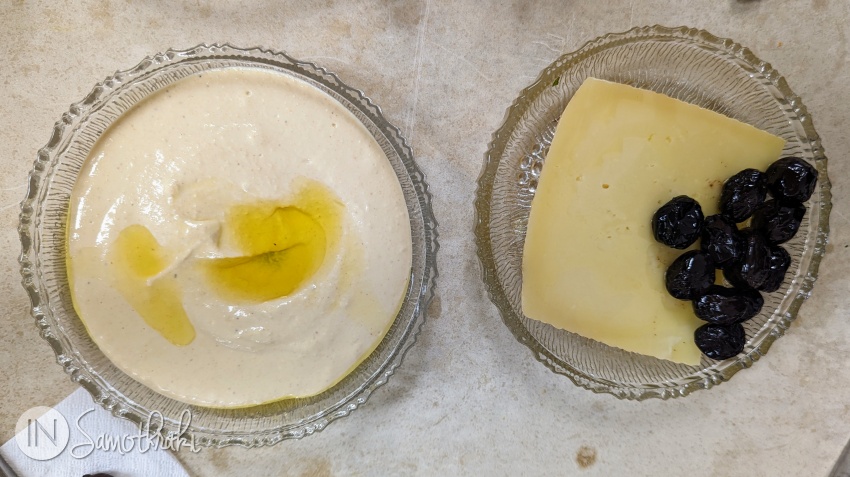
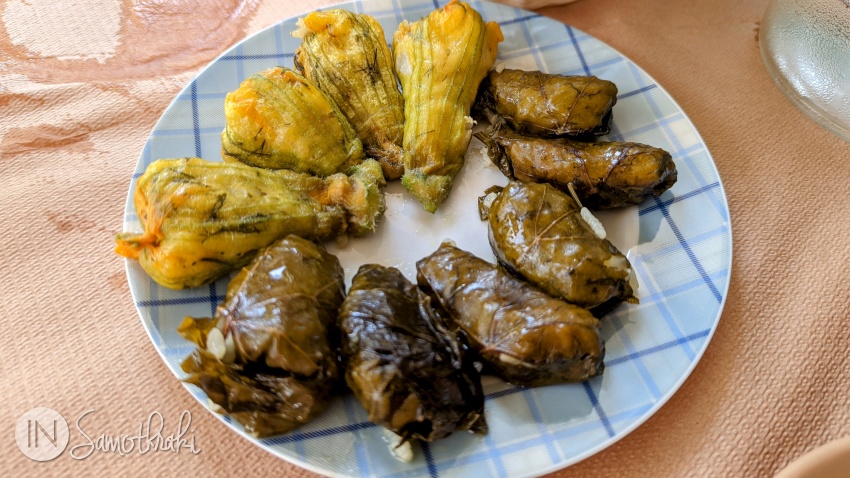
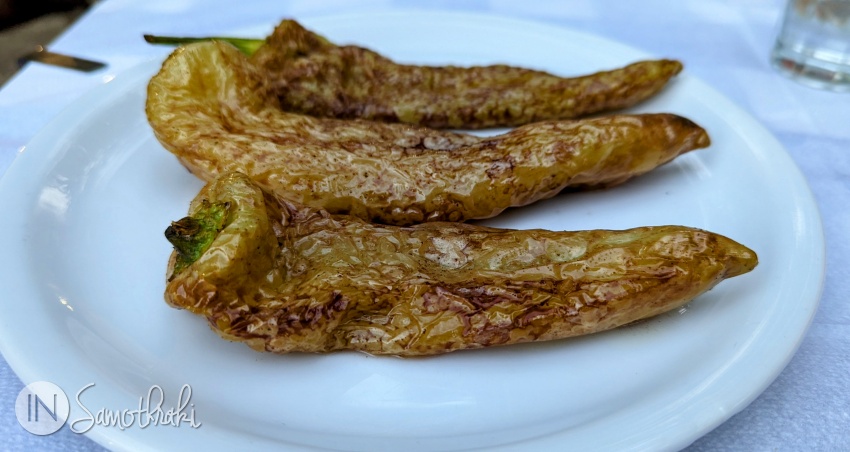
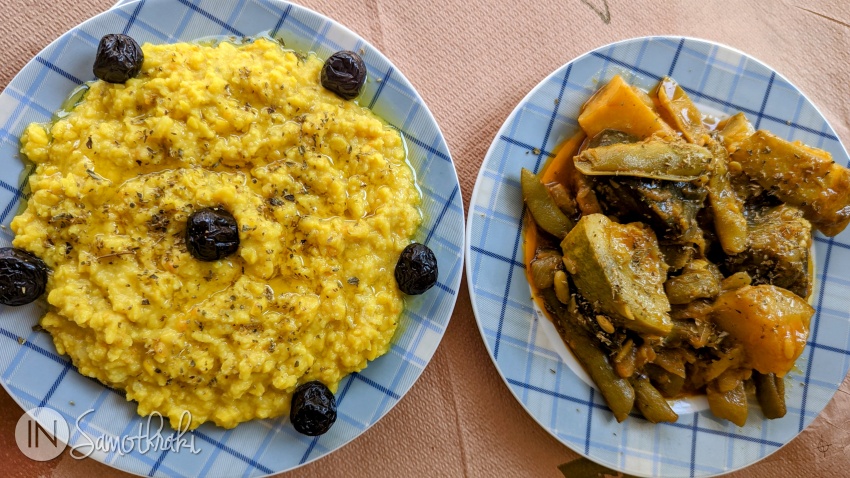
Katsikaki (goat), the island's culinary claim to fame
The highlight of Samothraki's cuisine is goat meat (katsikaki), cooked in many ways - on the spit, in a pan, in parchment, stew (stifado), with a side of rice (gorgovrasto), stuffed with rice, entrails and spices (gemisto), with wine, potatoes, tomatoes, eggplants, zucchini or even honey, quinces or plums. A portion costs 10-14 EUR, depending on the dish and the tavern.
Most of the goats on the island live freely, and their meat is tastier than in other places.
The village of Profitis Ilias, with its rotisserie-taverns O Vrachos (wholeheartedly recommend), Panorama, Paradeisos and I Pigi, is famous for its roasted goat. A kilogram of meat costs 30-32 EUR.
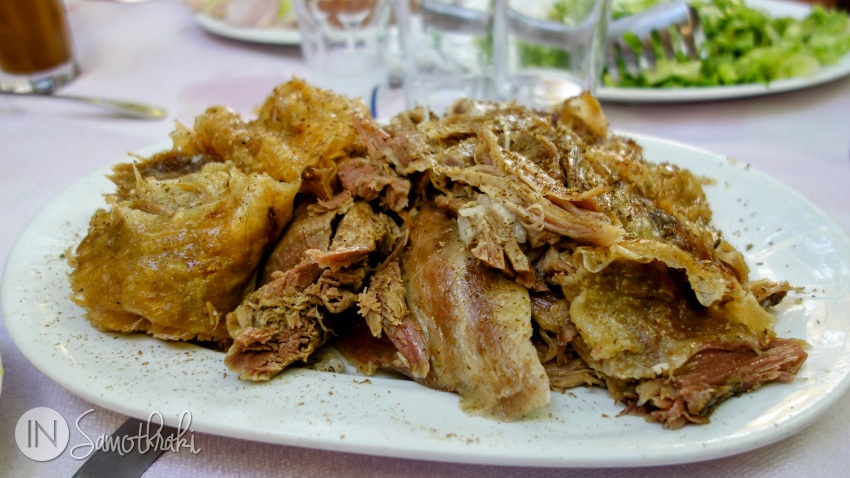
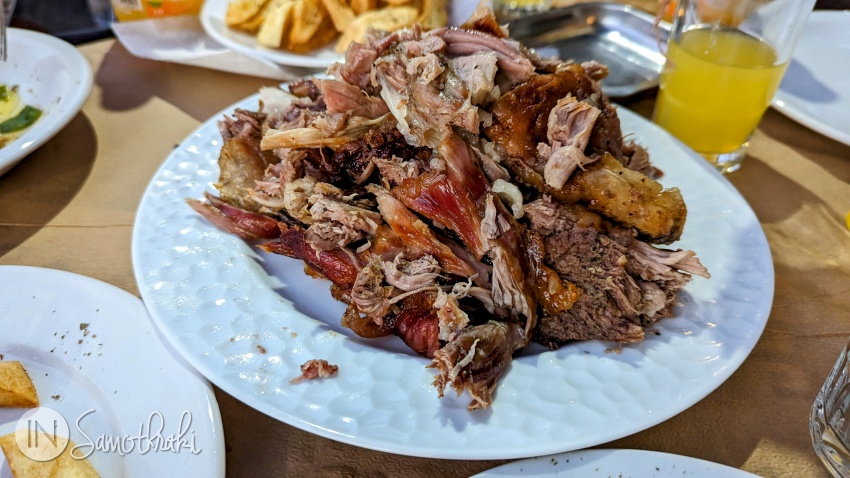
In the village of Ano Meria is Taverna Karydies, famous (and repeatedly awarded) for its gastronomic tradition and for the many dishes cooked with goat meat.
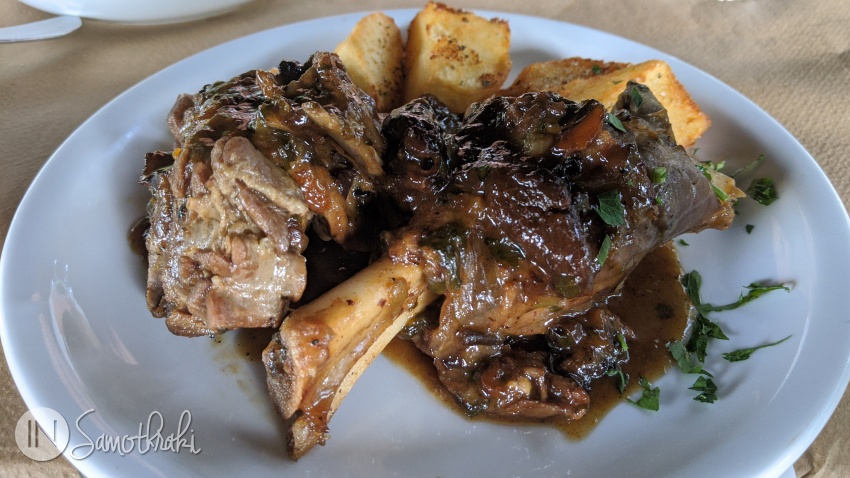
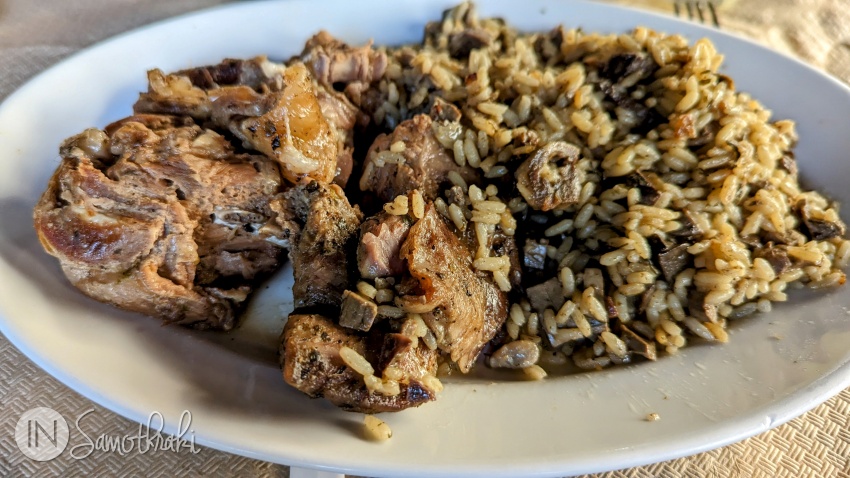
Gorgovrasto (meaning quickly boiled) is a notable traditional dish. The juice in which the meat was boiled is used to boil rice (with added milk and pepper). Gorgovrasto is specific to weddings and local celebrations (panigyri). It's prepared, for example, for the feast of Saint Paraskevi at the church of Agia Paraskevi in Ano Meria.
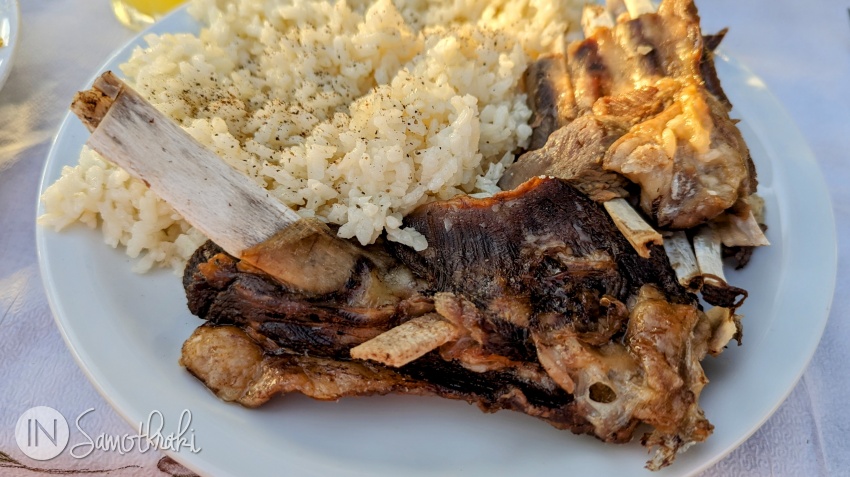
Besides rice and potatoes, goat meat is also served with pasta.
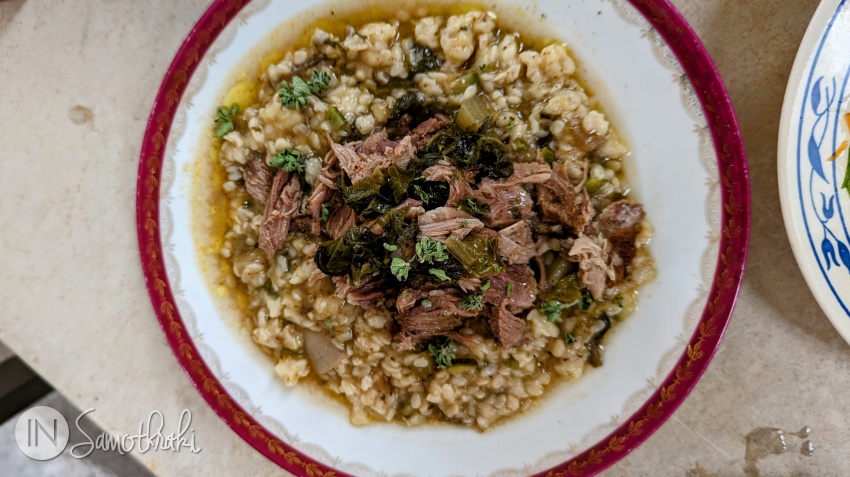
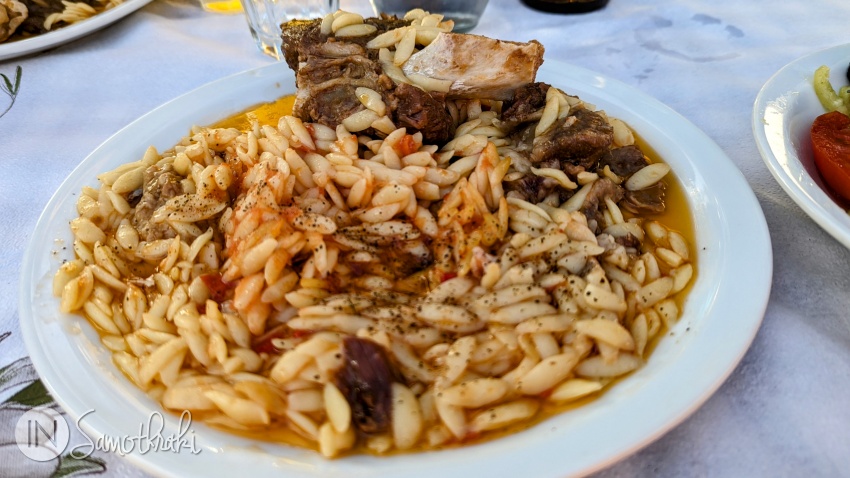
A peculiar dish is kokoretsi, prepared from goat entrails. Liver and rice are used to prepare tzigerosarmas, another dish specific to the area of Thrace.
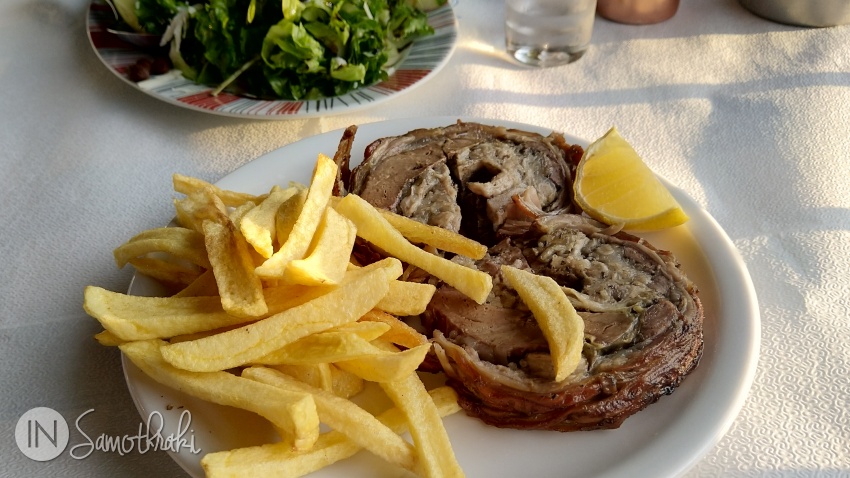

Fish and seafood
Even if goat meat is at the forefront of the local cuisine, Samothraki is still an island, so the taverns on the shore or near the sea will happily serve you fresh fish (psari) and seafood (thalassina).
There are quite a few fish and seafood taverns, among which: O Psaras near Therma, Argo between Paleopoli and Karyotes, Akrogiali in Lakkoma, To Limanaki (Charanas) and Synandisi in Kamariotissa, Ta Delfinia in Paleopoli and Nicholas on Pachia Ammos beach.
Sardines (fried or grilled) and fried anchovies are priced at 6-10 EUR/portion. The other fish have prices between 20 and 60 EUR/kilogram, depending on the type – mackerel, mullet, koutsomoures (a type of mullet), scrumbies, bream (tsipoura), mullet, melanouri (a type of sea bream), perch, cod, fagri (red sea bream), sargos (white sea bream), lithrini (red sea bream), gopa (a species of sea bream), glossa (sole) and others.
It's customary for the owner to call you inside to show you the catch of the day or present the fish he's about to grill on your plate.
Freshly grilled fish is sometimes served with a bowl of oregano and a bottle of ladolemono (an olive oil and lemon sauce) which is mixed vigorously before pouring it over the fish.
Large fish can be a bit pricey but can be shared between two or more people.
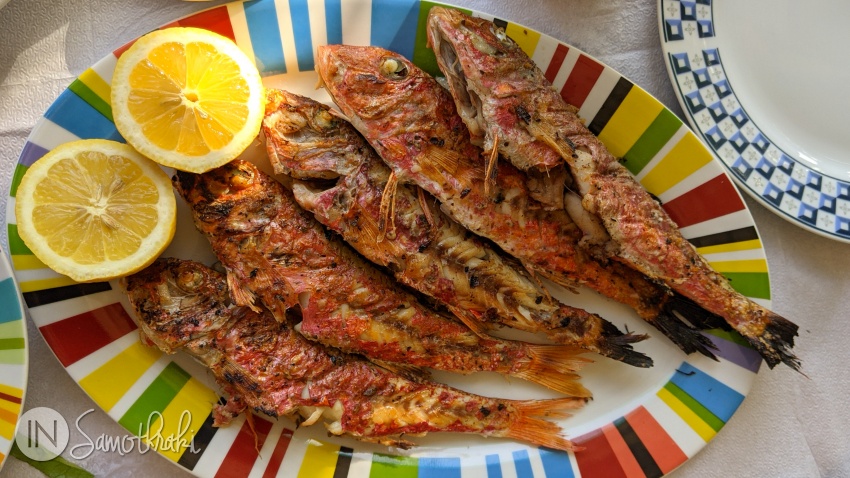
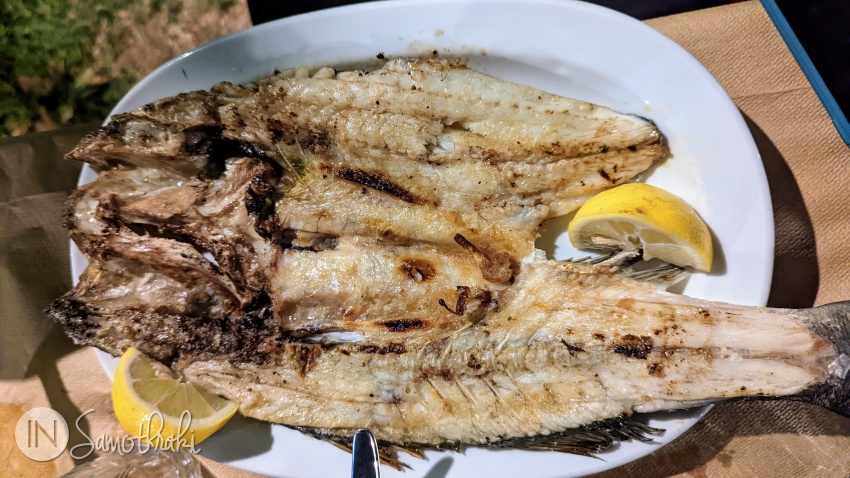
Among the seafood, squids (fried, grilled or stuffed), shrimps (roasted, fried, in pasta or with red sauce - saganaki), mussels, octopus and lobster can be found on the menus. Prices are generally 10-15 EUR, and the lobster is about 60 EUR.
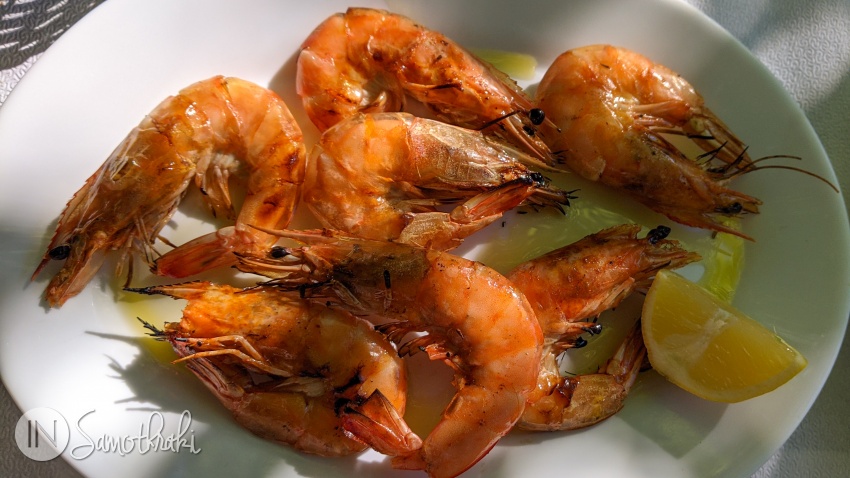
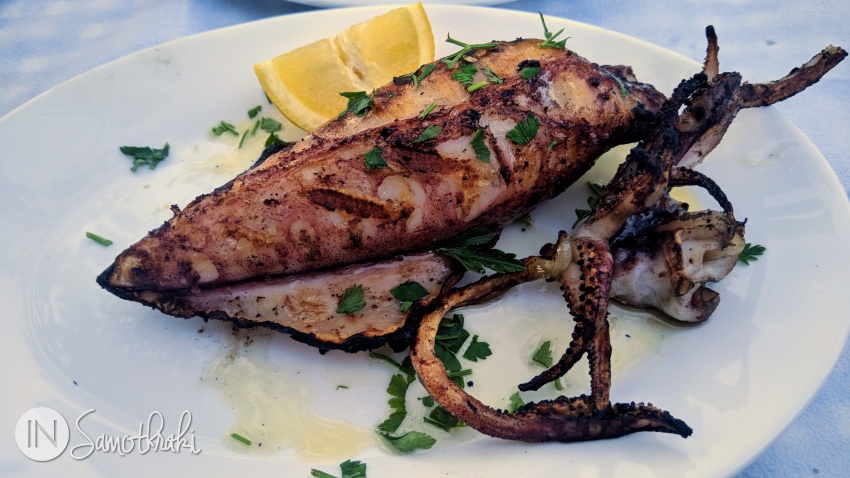
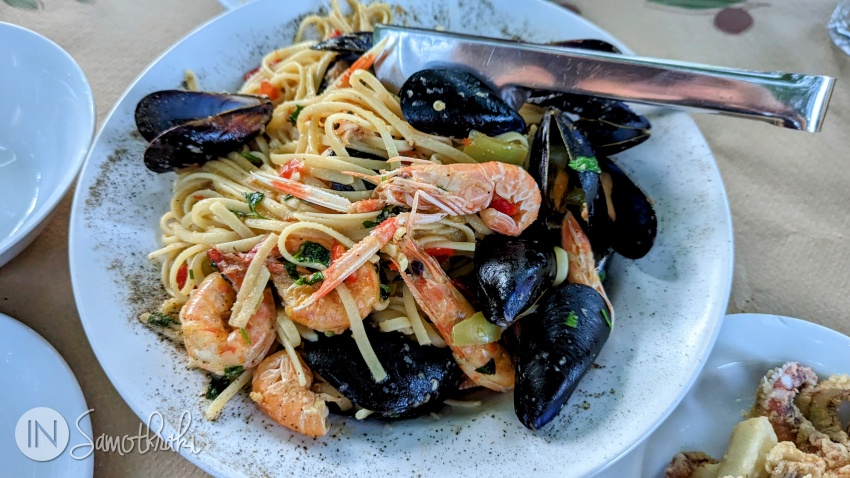
Octopus is usually prepared on the grill, but you can also find it as meatballs, in salad or boiled in vinegar. Mussels are either steamed, fried, with rice or saganaki.

Other types of meat
In addition to the many goat dishes, the menu of the Samothracian taverns also includes chicken, lamb or pork - pan-fried, grilled or baked, meatballs, sausages, burgers and skewers (souvlaki), at prices of 7-11 EUR.
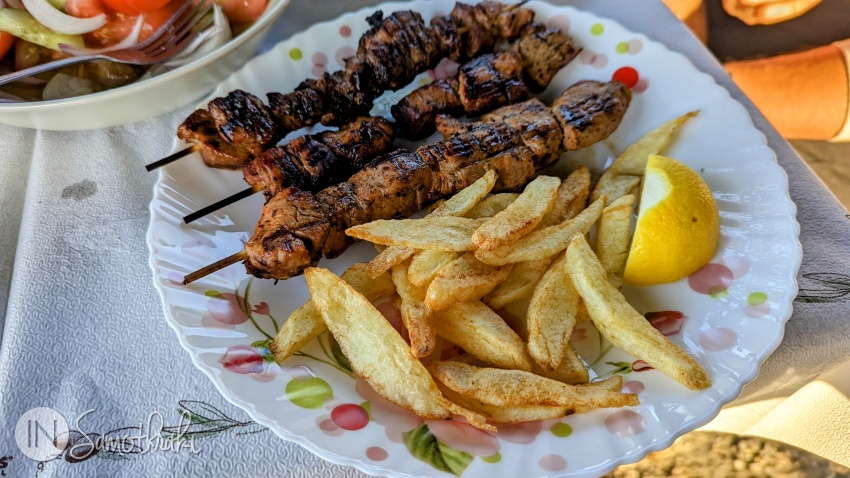
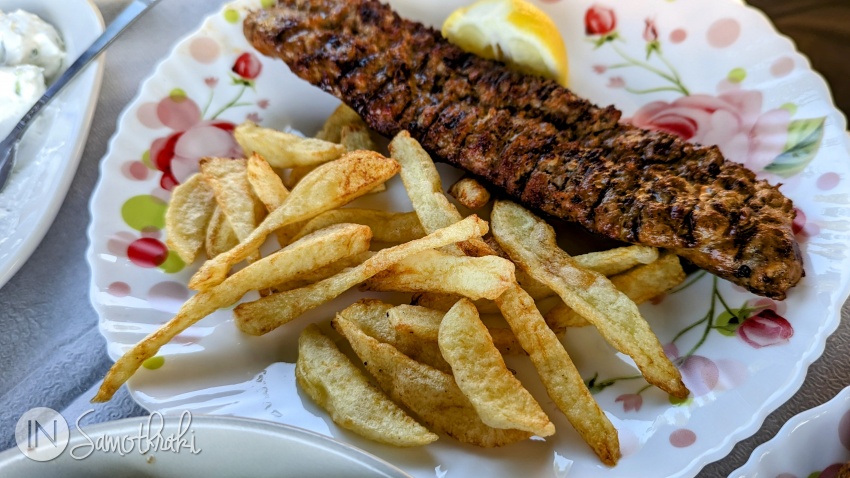
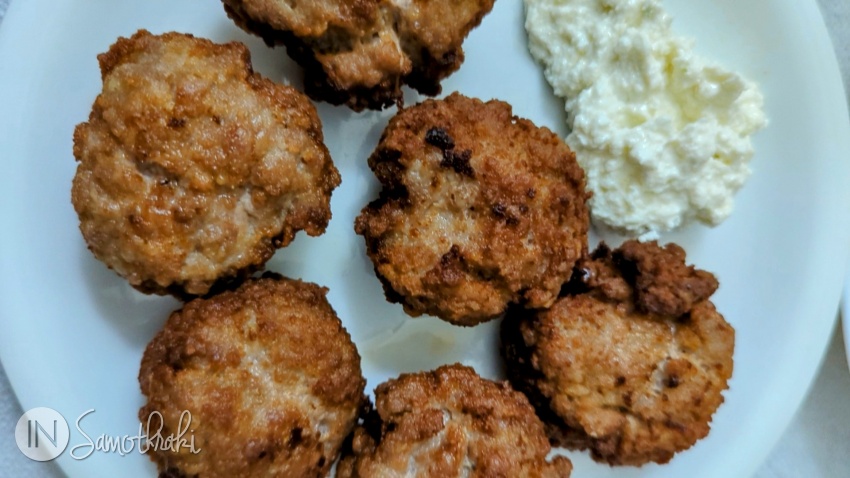
The real taste of Greek cuisine is felt in the cooked dishes. Try moussaka (in Greek it's masculine and is called mousakas), pastitsio (similar to lasagna), stuffed tomatoes, eggplant or zucchini, kavourmas (a Thracian recipe) or mandi (homemade pasta stuffed with meat minced and onion), stifado (stew), spetzofai (a spicy sausage dish), soutzoukakia (meatballs with red sauce) or the delicious baked veal with eggplant puree (moschari chounkiar).
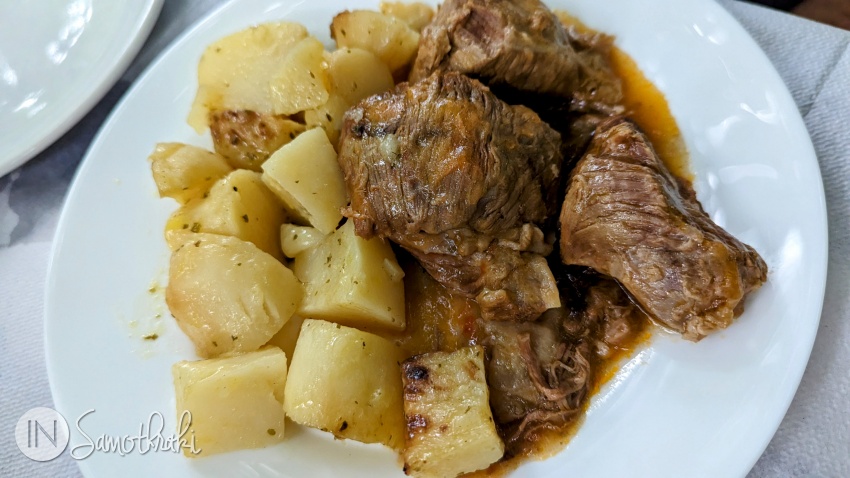
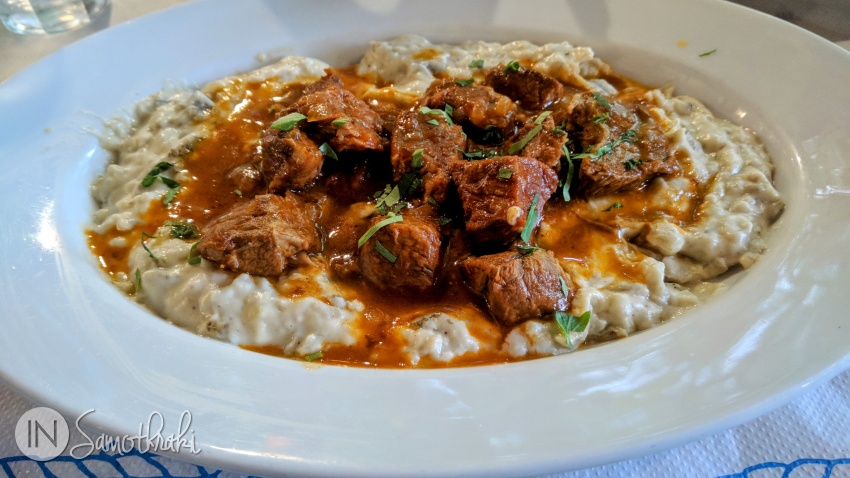
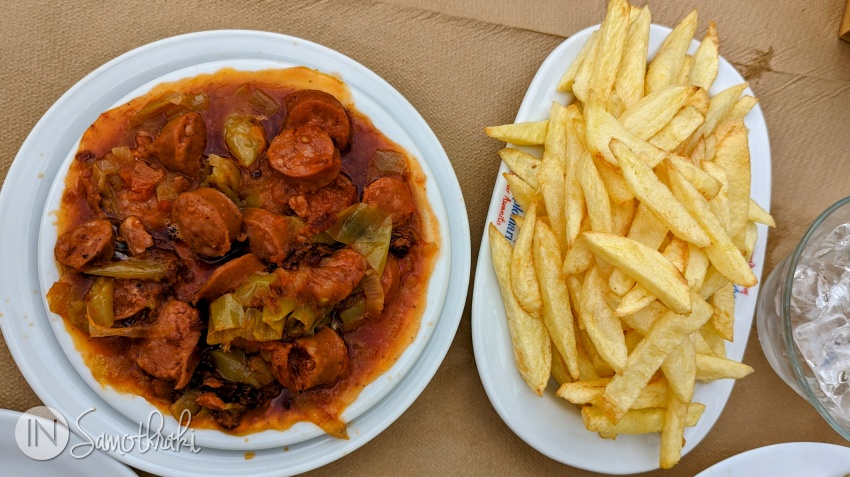
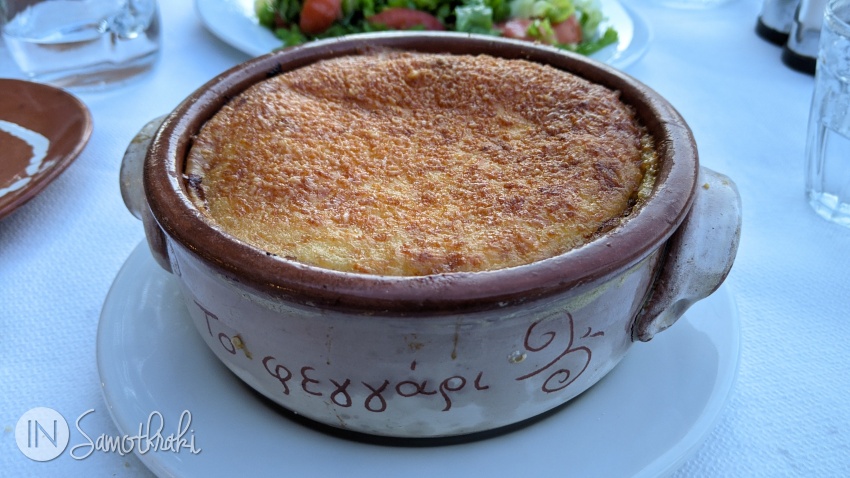
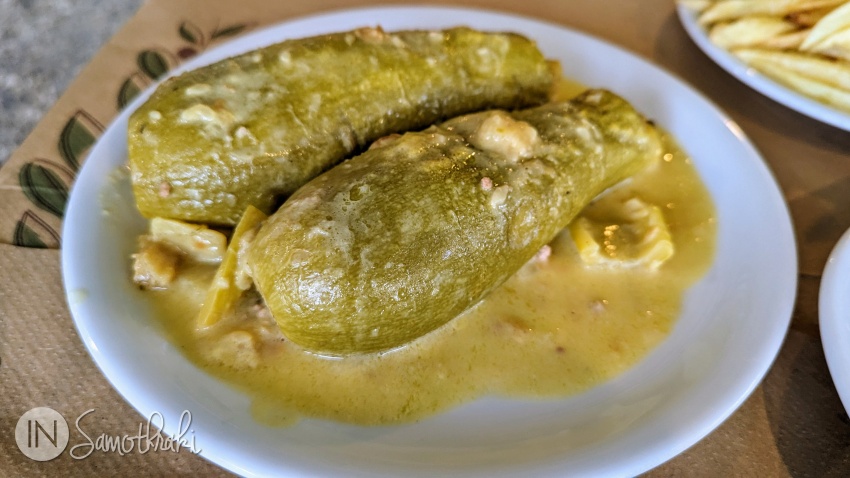

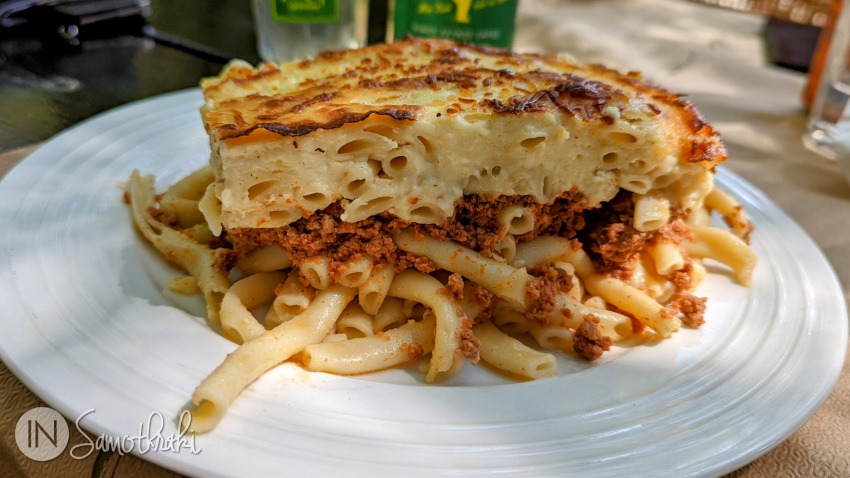
Vegetarian
Beyond the meat-based dishes, you will also find some vegetarian dishes on the menus: tourlou or briam (baked vegetable pot), chickpea stew, green or dry bean stew, the traditional tsigaristi fasolada (a recipe from Samothraki), spanakorizo (spinach with rice), grilled or stuffed vegetables.

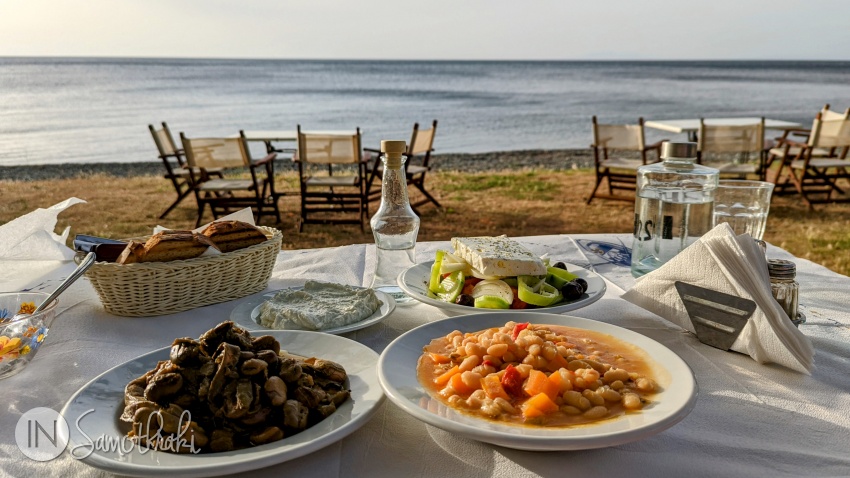
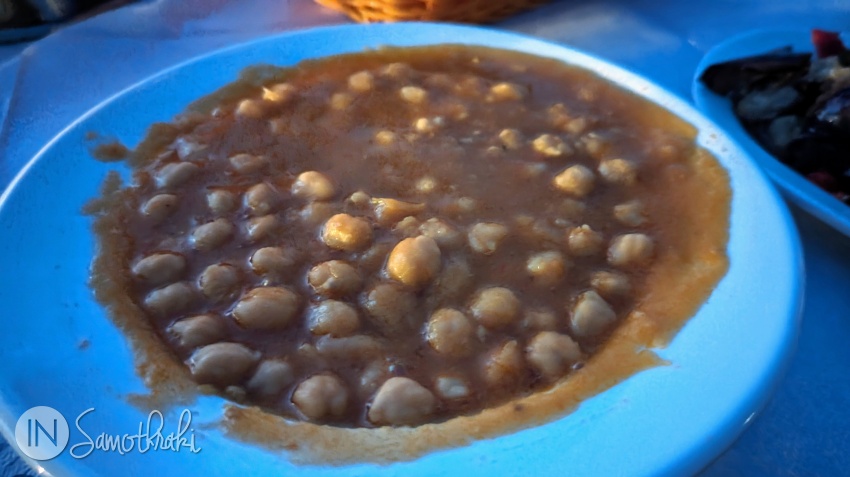
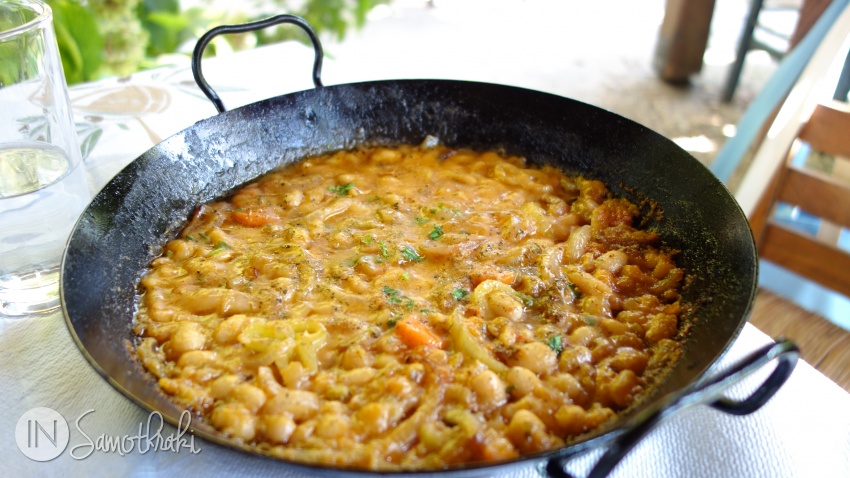
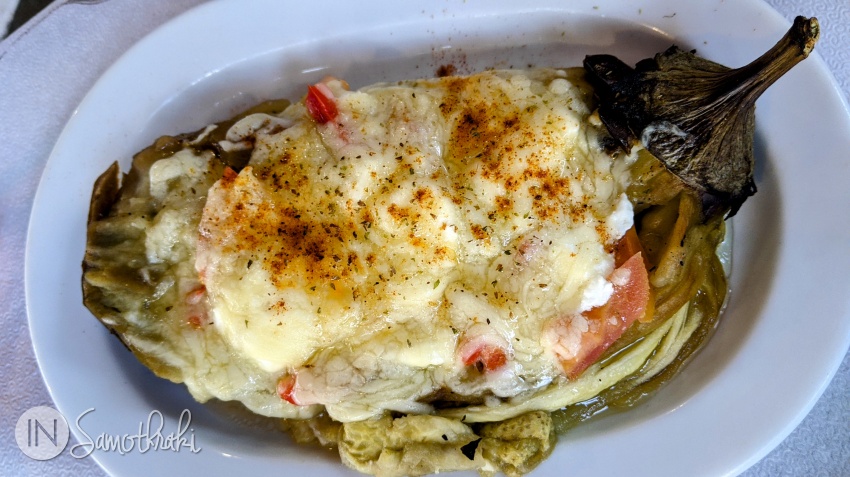
Salads
The most common salad is the Greek one, which is actually called choriatiki (peasant-style) and costs between 6 and 9 EUR, depending on the tavern. It is a large salad consisting of tomatoes, cucumbers, peppers, onions, olives and one or more slices of feta cheese on top, with olive oil and oregano sprinkled over it.

The other salads are priced around 4-6 EUR: green salad (marouli), beetroot salad (sometimes prepared with leaves), Hungarian salad (shredded cabbage, carrots and celery), tomato and cucumber, cabbage or arugula salad.
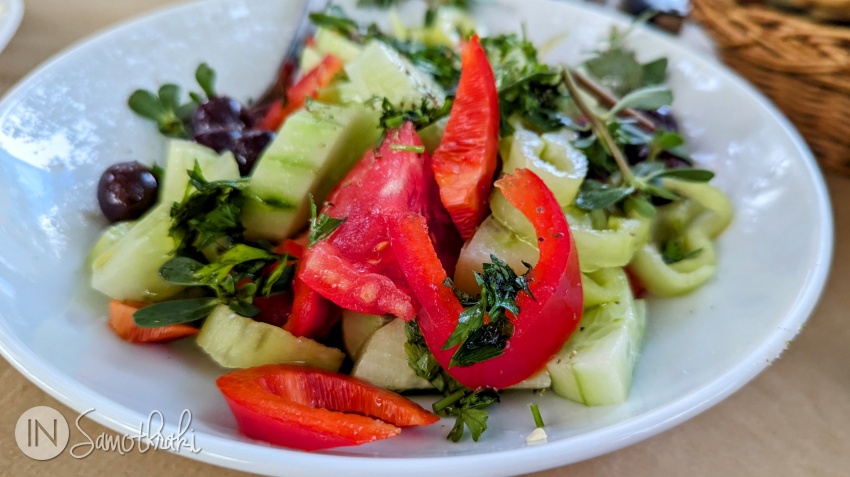
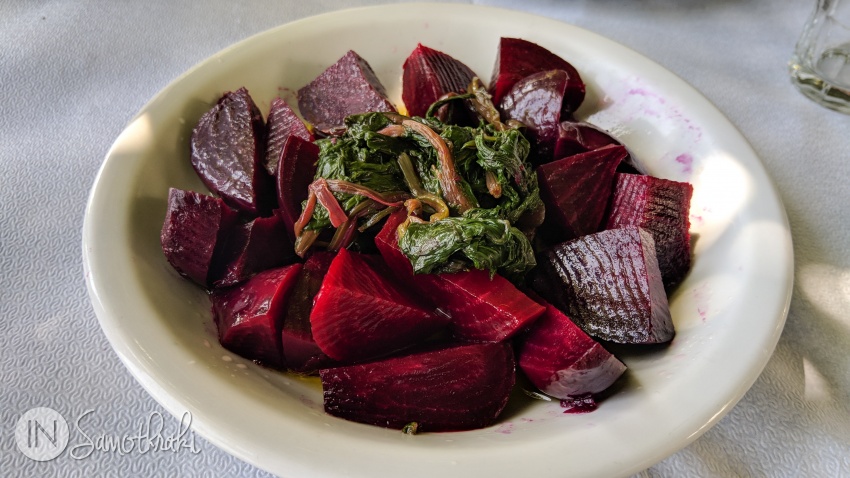
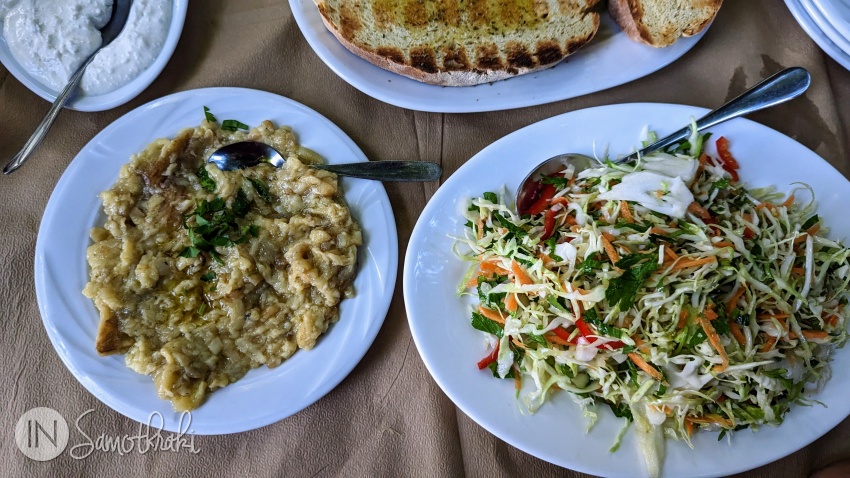
Chorta (or vlita) is a staple of many menus - a salad of green leaves, boiled or tempered, similar to beet leaves.
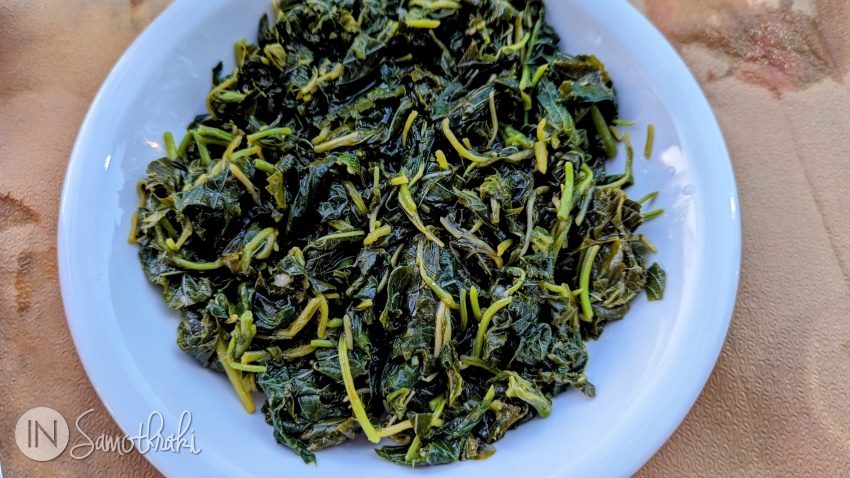
Sweets and desserts
Desserts are rarely found on the menu of taverns in Samothraki. If you've got a bit of a sweet tooth, you're better off going to a pastry shop like Sandigi. Especially in the off-peak season, it is customary to be offered a small plate of dessert on the house at the end of lunch or dinner. This can include some candied fruit, thick yogurt with jam, homemade cookies or watermelon.
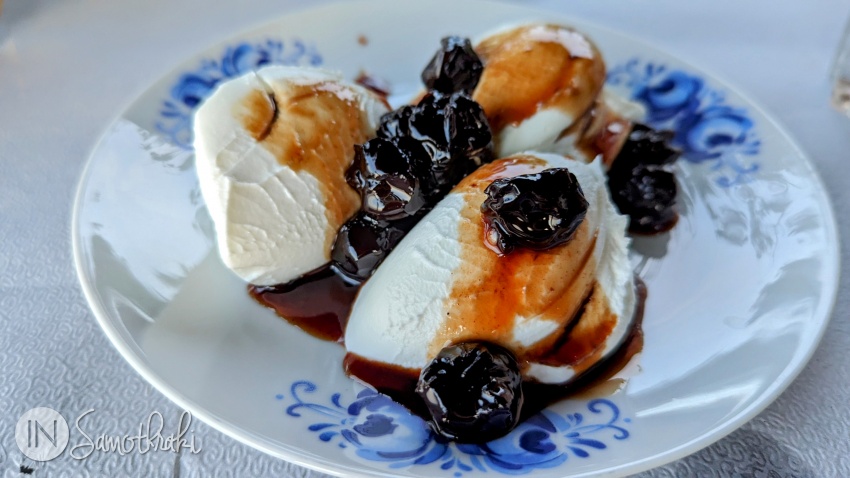
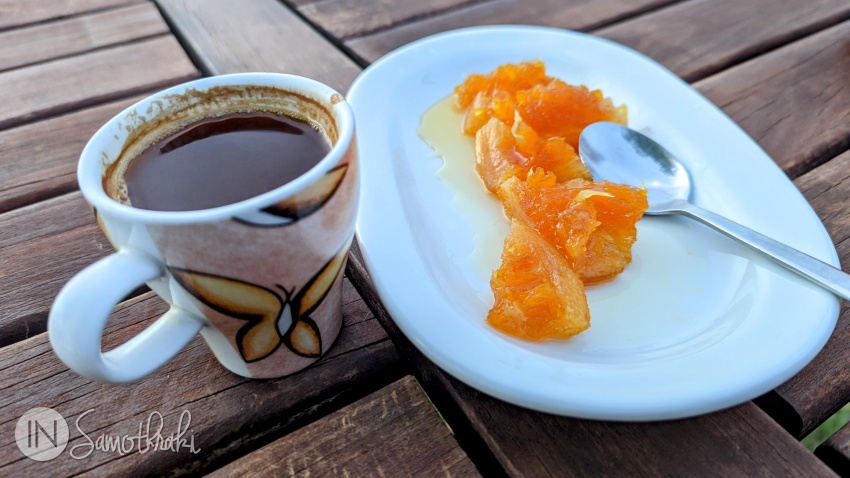
However, desserts can be found on the menu of cafés or at patisseries-confectioneries.
The specific fruit of the island is called praousti. The tree is not unlike a plum and is officially called Prunus domestica syriaca, better known as Mirabelle plum. The fruits are round, yellow-orange in color and sweet when ripe. The name praousti comes from the fact that they are usually ripe in August (pro augoustou). They are used to make jam or the traditional dessert, praousti koutaliou (spoon sweet). These "spoon" desserts are various fruits boiled and preserved in sugar syrup or honey, which are usually enjoyed with a spoon or teaspoon (hence the name) from glass bowls together with Greek coffee and a glass of water.
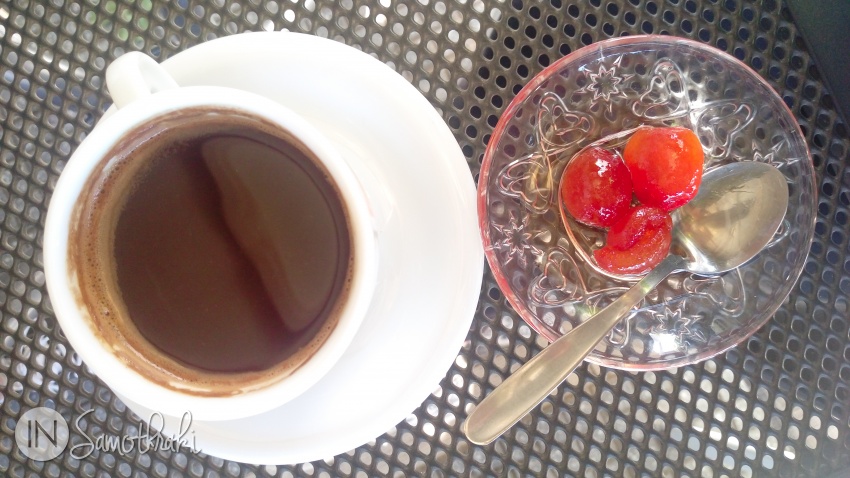
Another dessert characteristic of northern Greece and particularly the island of Samothraki is called chaslamas. It's a syrupy cake made mainly of flour, semolina and cinnamon.

A famous cake, with chocolate and vanilla ice cream, is pissa kai poupoula (meaning "tar and feathers"), prepared at the café O Lefkos Pyrgos in Chora, owned by Giorgos Stergios, a pastry chef who, except for the summer months, lives in France.

For pancakes go to Trapeza Café in Chora or to Kentriko in Kamariotissa.
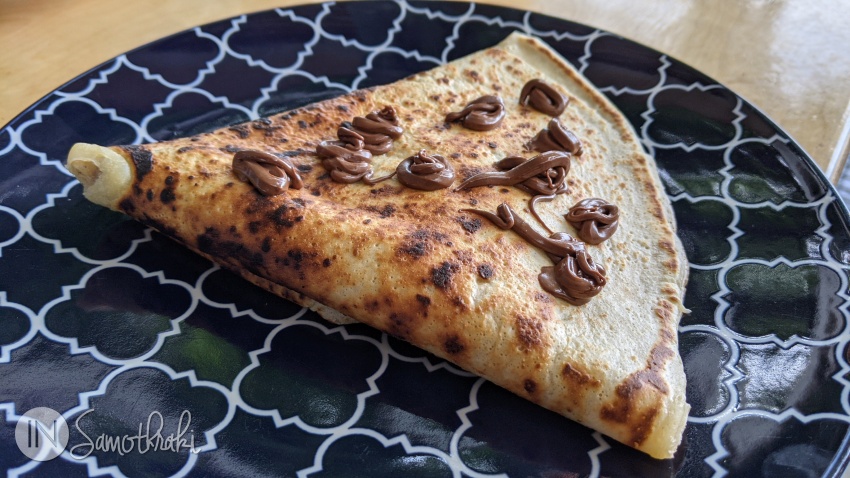
At the cafés, you can also find ekmek kataifi (at the Kalderimi cafe and at Lefkos Pyrgos), all kinds of cheesecakes, banoffee tart (at the O Pyrgos cafe near the citadel), chocolate, lemon and orange tarts (at Trapeza), various ice creams, tiramisu and desserts in a jar (at the Stathmos café in Chora) or Greek yogurt with jam.
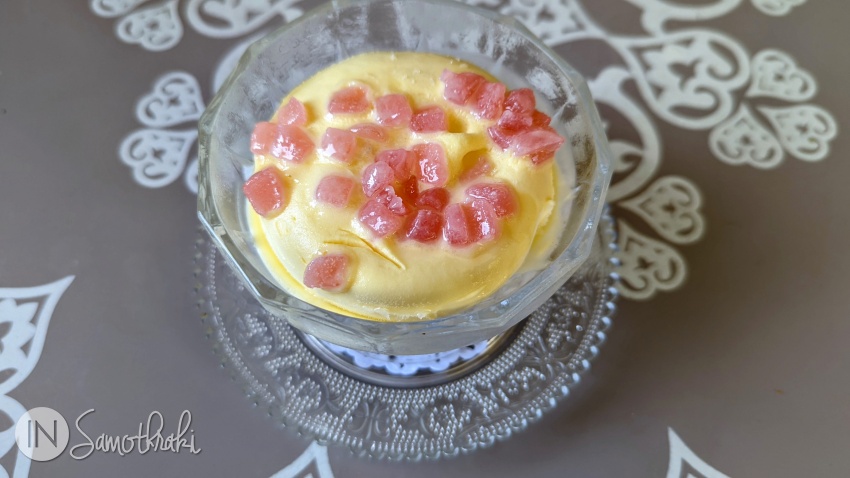
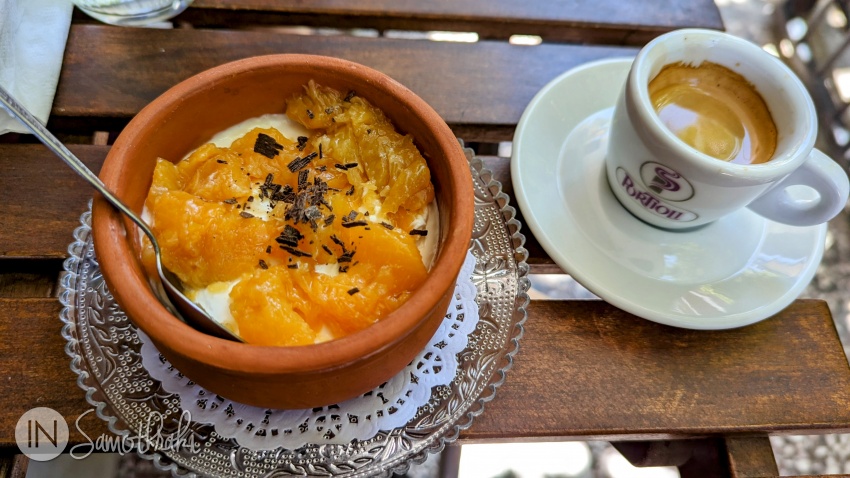
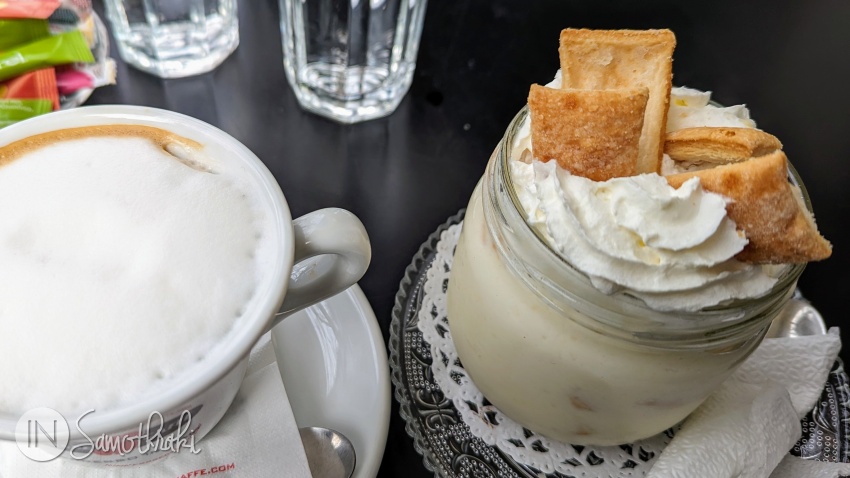
There are several pastry shops on the island, which also prepare confectionery: Falekas and Rania in Therma, Sandigi and Aggeliki in Kamariotissa. They serve baklava, bougatsa (a type of pie that can be both sweet and salty), galaktobureko (a pie with semolina and milk cream), samali (a cake with semolina), chaslamas, karydopita (walnut cake), portokalopita (orange syrup cake), milk rice, as well as various creams and jellies.
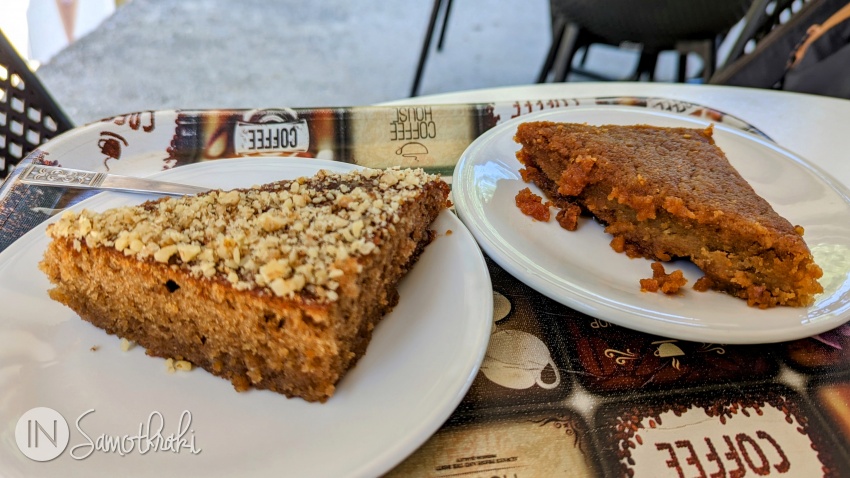
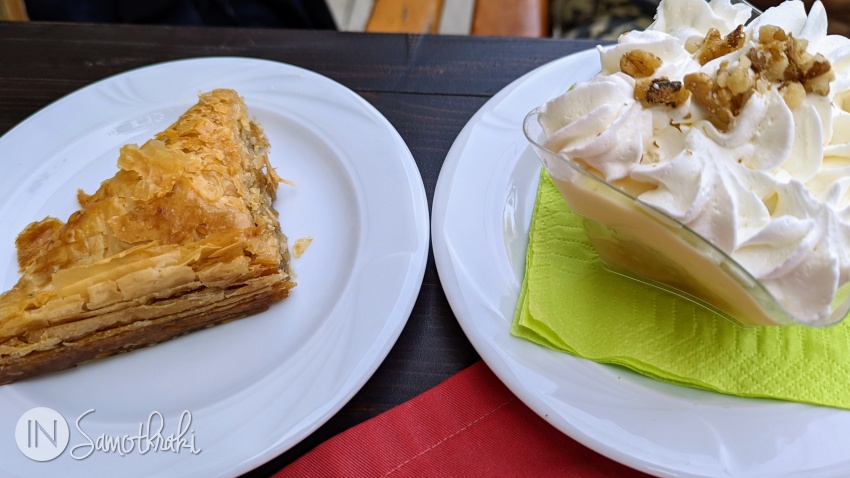

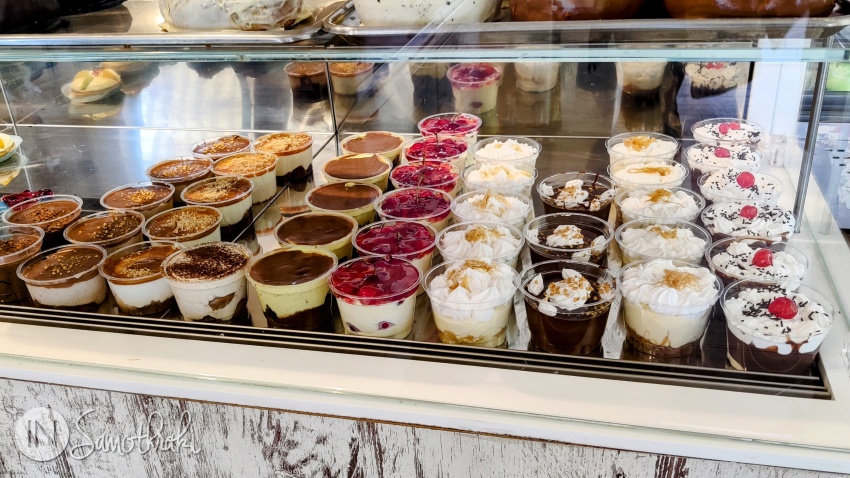
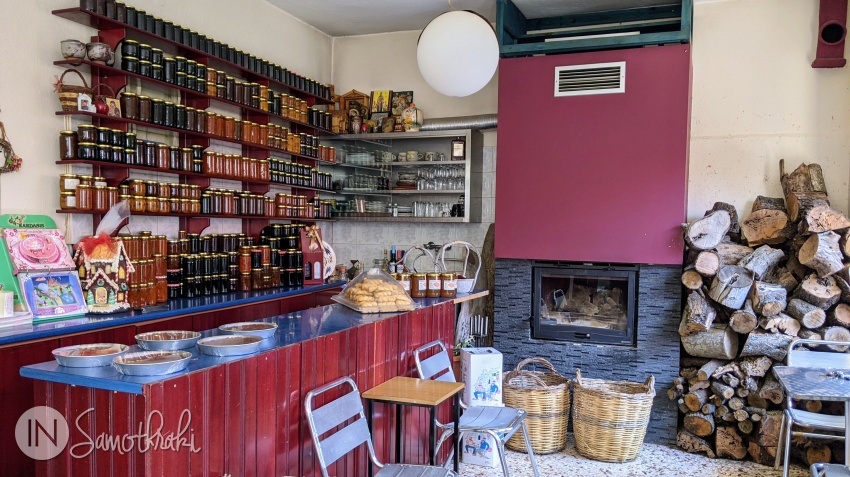
In Chora, at the I Samothraki shop, near the fire station, you can buy excellent homemade chocolate and other sweets.
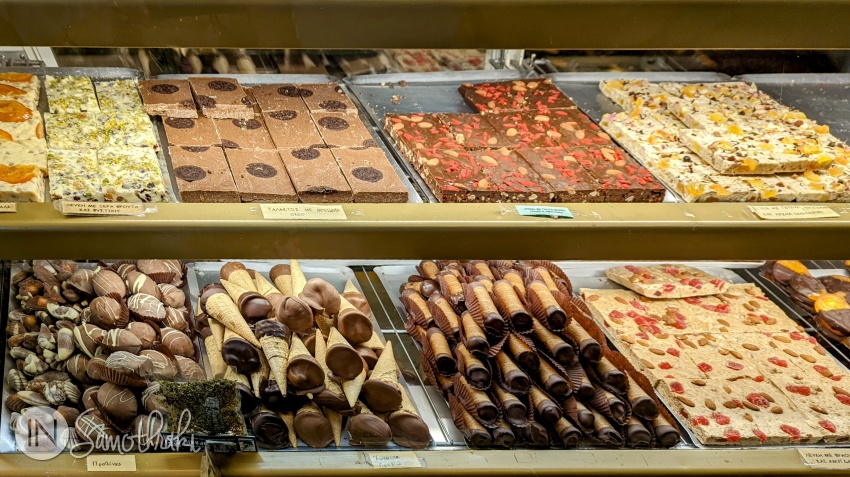
In Therma, at the 3 Amigos supermarket, the Zakatas family prepares sugar-free sweets with honey, sesame, hazelnuts, walnuts, pistachios and dried fruits.
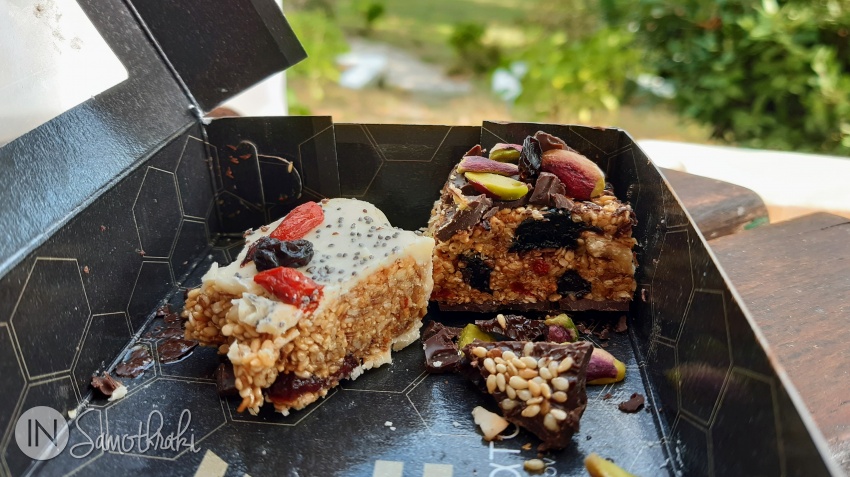
Non-alcoholic beverages
Greeks love frappe and you can often see them in cafés, having a chat and a glass of frappe. The original recipe is only with ness (soluble coffee), sugar, water, ice and possibly milk (no cream, no ice cream, no chocolate syrup) and costs 2-3.5 EUR. If you don't want any sugar, ask for frappe sketo, if you want it sweet, order metrio, and if you want it very sweet, order glyko.

Greek coffee (don't make the mistake of referring to it as "Turkish coffee" because the Greeks will be outraged and you might get an hour-long lecture on history and politics) is called ellinikos and usually costs 1.5-2 EUR. You can also use the expressions above (sketo, metrio, glyko) to indicate how sweet you prefer it. In some bars, you can also find a version of coffee from Alexandroupoli, stronger and darker in color (skouro), and at Trapeza you can also find coffee with mastic, very aromatic.
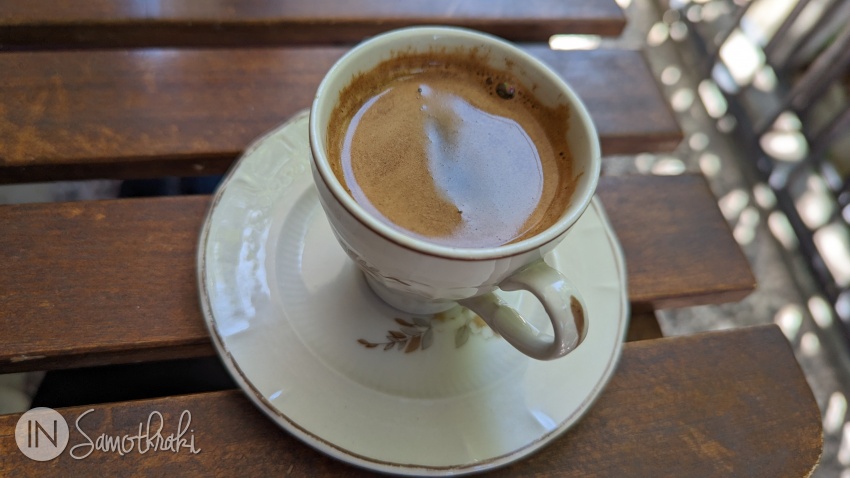
Those who can't live without espresso will find good espresso (and cappuccino) at Trapeza and Pyrgos in Chora, at Falekas in Therma, and at Kentriko and Sandigi in Kamariotissa.
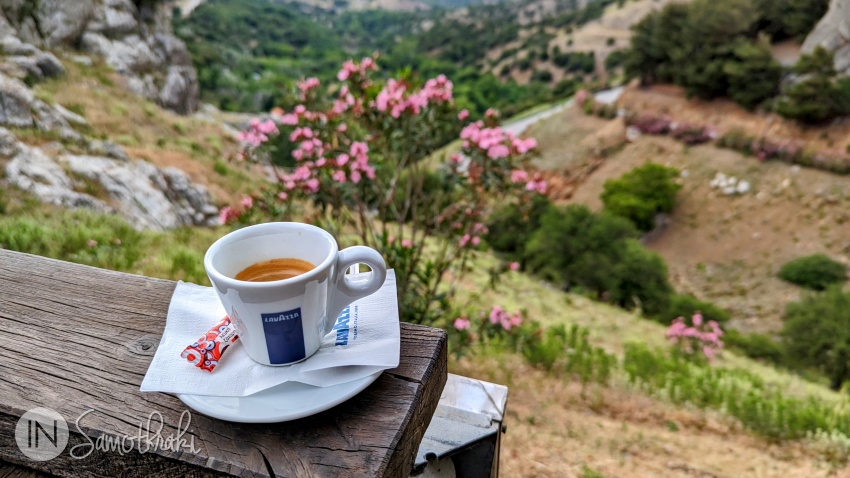
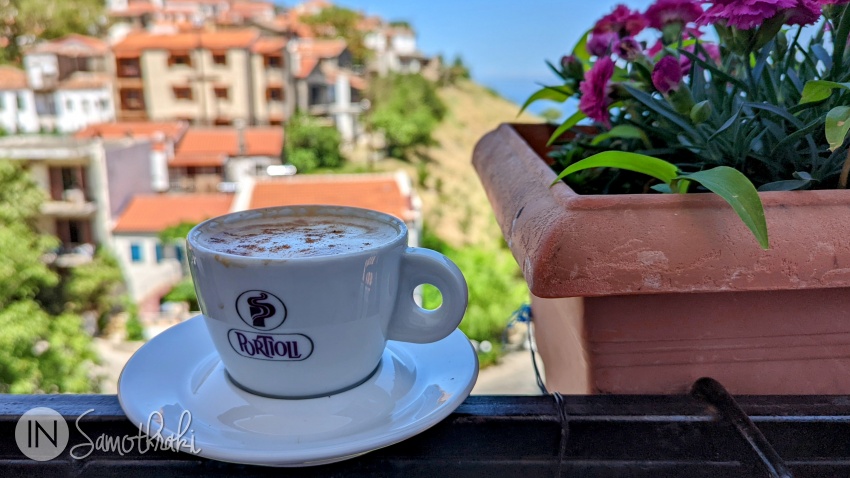
As for soft drinks, you should know that usually lemonada and portokalada refer to carbonated bottled drinks, like Fanta. The brands you can find in Samothraki are Vikos and Esperia Mihailidis (produced in Alexandroupolis), which cost 2-3 EUR in cafés. If you want a lemonade made from fresh lemons, you should look for homemade (spitiki lemonada) or fresh (freskia) lemonade. You can find it, among others, at Lefkos Pyrgos and at Trapeza (where you can also order lemonade with lavender), for the price of 4.5 EUR.
Alcoholic beverages
The traditional drink of the island is tsipouro - a 40% grape brandy, without anise. At some taverns, you will also find tsipouro with anise, but also ouzo, by the glass or carafe. It's consumed with plenty of ice.
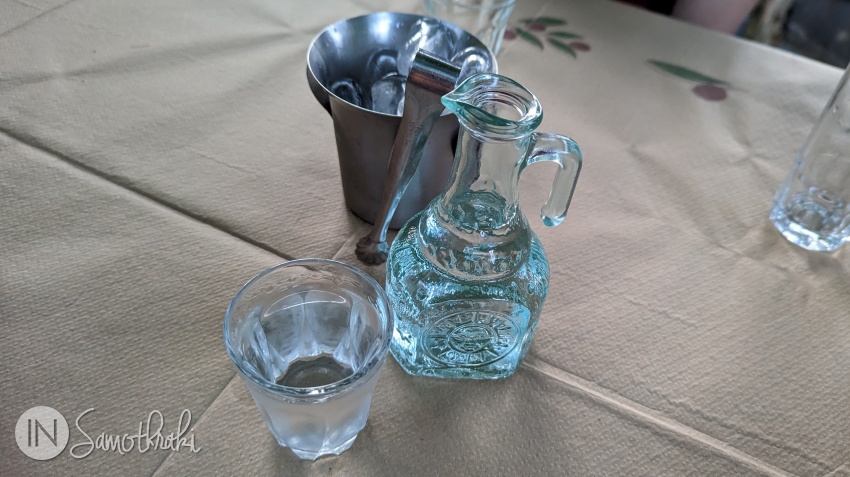
Samothraki has its own beer - it's called Fonias and it's a very good craft beer, produced on the island and whose price in restaurants is about 5-6 EUR/bottle. Other beers you may find are Vergina, Mamos, Nymfi, Alpha, Fix, Mythos, Amstel, Kaiser or Heineken at 3-4 EUR/bottle. The menu at Lefkos Pyrgos includes an entire page of craft beers, Greek and foreign.

Unfortunately, I have no special recommendations for local wines. Until a few years ago, the Melmar Winery operated in the village of Dafnes, producing successful (and award-winning) wines, both red and white. For various reasons, however, it was closed. If you're a wine drinker, it's better not to ask for the house wine, as you'll be disappointed. (Good) bottled wines from other parts of Greece may be available depending on the bar or taverna.
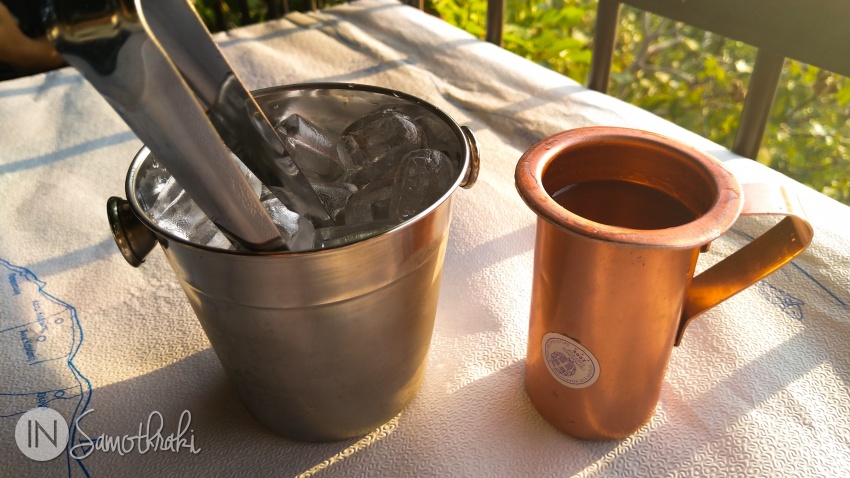
If you are a cocktail lover, there is a cocktail bar in Chora called Lydia. You will also find an impressive selection of cocktails at Lefkos Pyrgos. There are also cocktails at other cafés and bars, such as Trapeza, Meltemi, Kalderimi and Pyrgos in Chora, at Saoki Beach Bar on the beach in Therma or at Scholeio and a few more places in Kamariotissa.
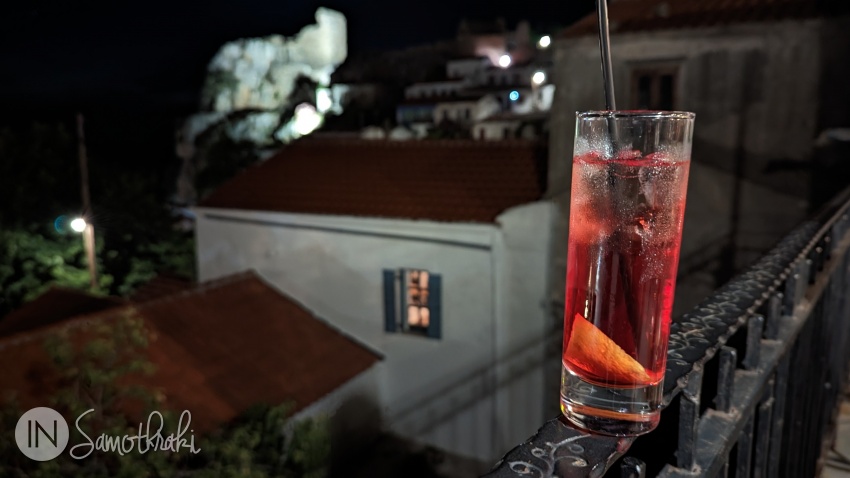
You can also try the local homemade liqueurs. At the Krimniotissa tavern near the Panagia Krimniotissa church, you can find praousti, cherry, walnut or koumaro liqueur (the fruit of the arbutus unedo tree, popularly called "strawberry tree"). I also recommend the liqueurs made by Ilias at Trapeza Café.
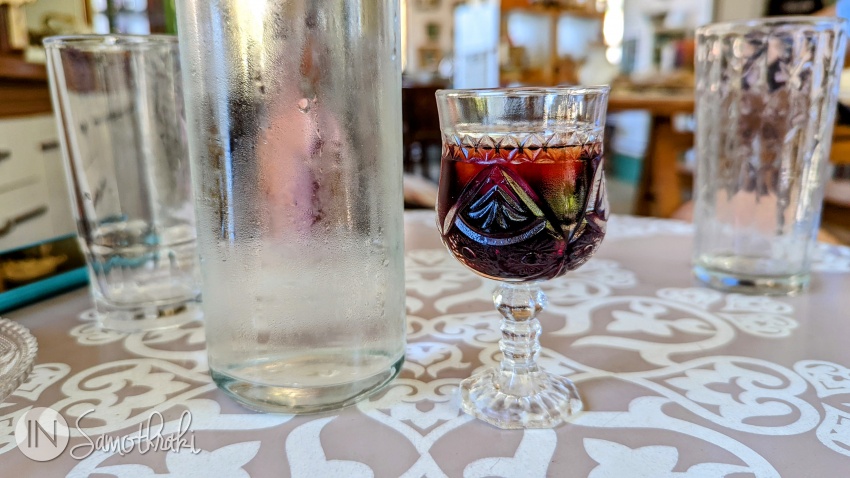
Snacks and starters
Snacks, called mezedes (singular mezes) oftentimes fondly called mezedakia, deserve a special section. You can find them in cafes and bars, but sometimes are not even listed on the menu. They are small plates with different appetizers and dishes, which change from one day to the next and perfectly accompany tsipouro and drinks in general, but also the conversations with those around.
Mezedakia are ideal to stave your hunger between meals or late into the night, after one too many drinks.
Some places called mezedopoleio serve only mezedes, a few cooked dishes and drinks. Such examples are Mezedopoleio Stavroula in Lakkoma or Mezedopoleio To Xiropotamo, in the village of Xiropotamos, at the start of the path to the pools of the homonymous river.
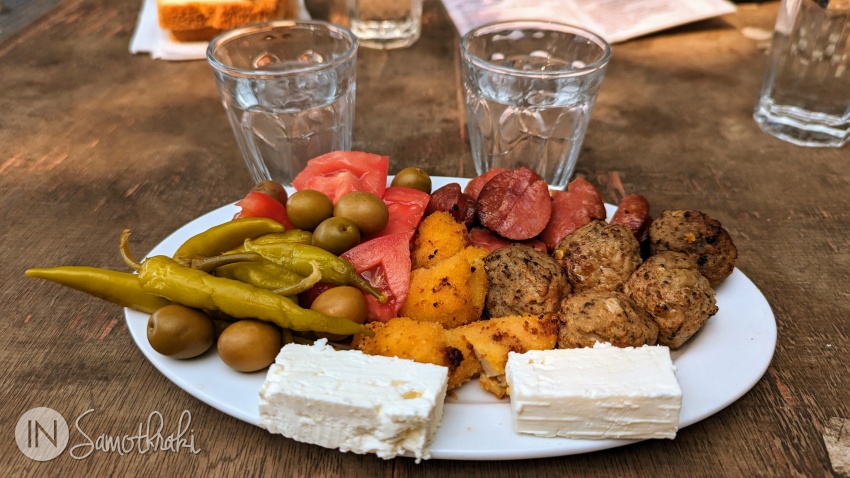

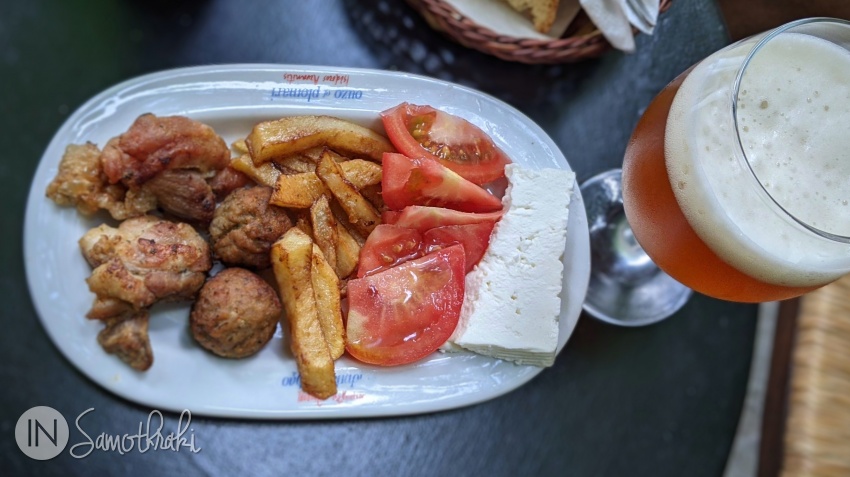
In Greek
Kalì òrexi! = Enjoy your meal!
Yia mas! = Cheers!

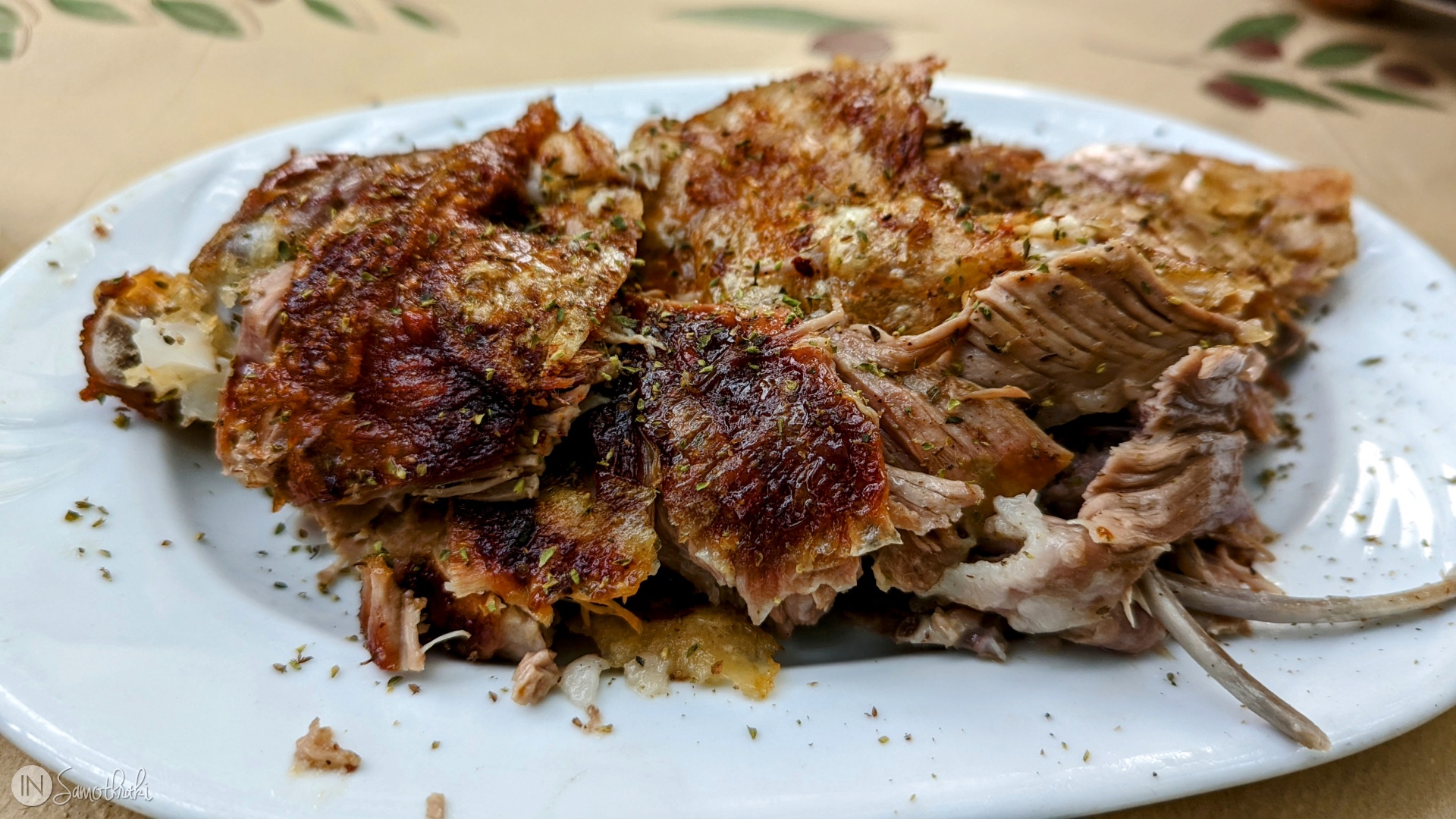
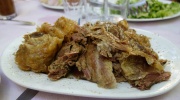 Goat on a spit at Taverna O Vrachos
Goat on a spit at Taverna O Vrachos
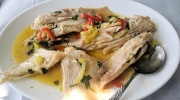 Fish and sea food at Taverna Akrogiali
Fish and sea food at Taverna Akrogiali
 Sunset panorama at Taverna Paradeisos
Sunset panorama at Taverna Paradeisos
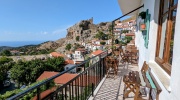 Trapeza, the coffee shop with a view
Trapeza, the coffee shop with a view
 The goat specialists of Karydies Taverna
The goat specialists of Karydies Taverna
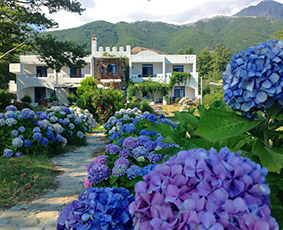
Thanks!
They are quite recent.